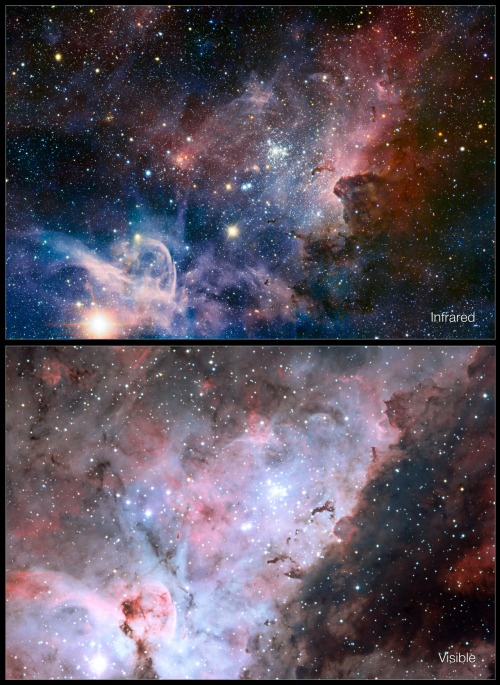Solar System: Things To Know This Week
Solar System: Things to Know This Week
Our solar system is huge, so let us break it down for you. Here are a few things to know this week:
1. We’re Going In

To be honest, Jupiter is kind of a monster. Not only is it the biggest planet in the solar system, but it also wields the most dangerous radiation and other powerful forces. Despite the risks, our Juno probe is going in close, because Jupiter also holds precious clues to how the planets formed, including our own. Arrival date: July 4. Watch the Juno mission trailer video HERE.
2. Moon Maps

The moon is beautiful in the sky, and also up close—sometimes even in the maps that scientists use to study its surface. Here are some evocative maps that lunar geologists have drawn up to chart the landscapes in the moon’s dramatic Tycho Crater. Take a look HERE.
3. That’s No Moon…Sort Of

The full moon we’ll see this week is not Earth’s only companion in space. Astronomers have discovered a small asteroid in an orbit around the sun that keeps it near the Earth, where it will remain for centuries. But it’s not exactly a second moon, either.
4. Power Blast

Venus has an “electric wind” strong enough to remove the components of water from its upper atmosphere, which may have played a significant role in stripping Earth’s twin planet of its oceans, according to new results from the European Space Agency (ESA) Venus Express mission by NASA-funded researchers.
5. How Green (Well, Red) Was My Valley

“Marathon Valley” slices through the rim of a large crater on Mars. It has provided fruitful research targets for our Opportunity rover since July 2015, but now the rover’s team is preparing to move on.
Want to learn more? Read our full list of the 10 things to know this week about the solar system HERE.
Make sure to follow us on Tumblr for your regular dose of space: http://nasa.tumblr.com
More Posts from Littlecadet-biguniverse and Others

M94, Cat’s Eye Galaxy

Vdb 158 and PLN 110-12.1
Credit: Jimmy Walker


TODAY IN HISTORY: The spectacular rings of Saturn, August 23, 1981, observed by the Voyager 2 space probe.

Milky Way js

The Running Chicken Nebula.
Image Credit & Copyright: Andrew Campbell

The violent past of our galaxy’s black hole could help us solve a cosmic mystery
The supermassive black hole at the center of our galaxy is pretty quiet now, but new research suggests that 6 million years ago it was raging and gobbling up matter. Scientists think it could explain a mysterious disappearance.
Follow @the-future-now

Saturns north pole hexagon.
js

Infrared/visible-light comparison of the Carina Nebula
js
-
 the-orangeauthor liked this · 4 years ago
the-orangeauthor liked this · 4 years ago -
 euphorion10120 liked this · 5 years ago
euphorion10120 liked this · 5 years ago -
 yamumsathot liked this · 6 years ago
yamumsathot liked this · 6 years ago -
 neverdoubtthemold liked this · 6 years ago
neverdoubtthemold liked this · 6 years ago -
 nlockett reblogged this · 7 years ago
nlockett reblogged this · 7 years ago -
 nlockett liked this · 7 years ago
nlockett liked this · 7 years ago -
 chvrchilllll liked this · 8 years ago
chvrchilllll liked this · 8 years ago -
 gotink56 liked this · 8 years ago
gotink56 liked this · 8 years ago -
 lameasznigga-blog liked this · 8 years ago
lameasznigga-blog liked this · 8 years ago -
 fujoshingout reblogged this · 8 years ago
fujoshingout reblogged this · 8 years ago -
 littlecadet-biguniverse reblogged this · 8 years ago
littlecadet-biguniverse reblogged this · 8 years ago -
 ostentatiousrrex liked this · 8 years ago
ostentatiousrrex liked this · 8 years ago -
 popizor-blog reblogged this · 8 years ago
popizor-blog reblogged this · 8 years ago -
 dorkla liked this · 8 years ago
dorkla liked this · 8 years ago -
 shpadoinkley-blog liked this · 8 years ago
shpadoinkley-blog liked this · 8 years ago -
 mrvmt liked this · 8 years ago
mrvmt liked this · 8 years ago -
 tiranosauriosrex liked this · 8 years ago
tiranosauriosrex liked this · 8 years ago -
 amelitalia liked this · 8 years ago
amelitalia liked this · 8 years ago -
 brandigates liked this · 8 years ago
brandigates liked this · 8 years ago -
 roseyboye-moved liked this · 8 years ago
roseyboye-moved liked this · 8 years ago -
 snickerdoodlles reblogged this · 8 years ago
snickerdoodlles reblogged this · 8 years ago -
 snickerdoodlles liked this · 8 years ago
snickerdoodlles liked this · 8 years ago -
 darkspellmaster liked this · 8 years ago
darkspellmaster liked this · 8 years ago -
 merlins-sherlocked-in-the-t-blog liked this · 8 years ago
merlins-sherlocked-in-the-t-blog liked this · 8 years ago -
 meneldil-blog liked this · 8 years ago
meneldil-blog liked this · 8 years ago -
 rgloom liked this · 8 years ago
rgloom liked this · 8 years ago -
 yozoshimada liked this · 8 years ago
yozoshimada liked this · 8 years ago -
 universenbummler liked this · 8 years ago
universenbummler liked this · 8 years ago -
 rekaidk666 liked this · 8 years ago
rekaidk666 liked this · 8 years ago -
 theesmartblonde liked this · 8 years ago
theesmartblonde liked this · 8 years ago -
 cesquis31-blog liked this · 8 years ago
cesquis31-blog liked this · 8 years ago -
 fleurdebach5-blog liked this · 8 years ago
fleurdebach5-blog liked this · 8 years ago -
 rod-9 liked this · 8 years ago
rod-9 liked this · 8 years ago
GREETINGS FROM EARTH! Welcome to my space blog! Let's explore the stars together!!!
144 posts